So you’ve been thinking about tackling some of the clutter around your home, but you’re unsure where to start? Do you find all the different organising strategies out there confusing? Should you proceed room-by-room, use the Konmari method, or set timers, or what? What if you just want to start somewhere, with anything? Look no further, I’ve compiled an easy free printable decluttering checklist for you. Read on for all the declutter ideas, or skip straight to the download here.
What can you declutter today?
This super easy A–Z cheat sheet contains 26 different things you can declutter today. You can download a compact one-page version of it here in PDF format. Refer to it at random intervals when you want to tackle one little corner of your home for a few minutes. Or, run through the entire checklist in one burst.
From A for appliance manuals, to Z for zines, I bet you have all of these thing scattered around your place. Let’s get started!
Table of Contents
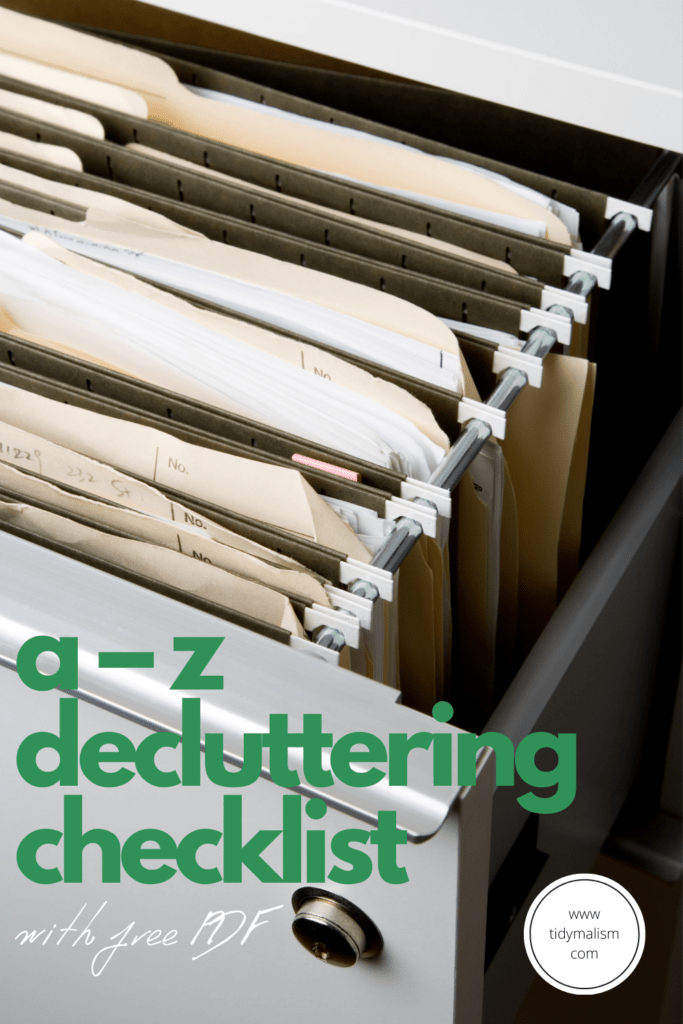
A – Appliance Manuals
If you’re a neat freak like I am, you likely have kept every piece of original packaging and every manual for all of your electronic gadgets and home appliances. I for one tend to do this in case I ever want to re-sell an item. After all, you can command a higher price on the second hand market if you include everything you originally got from the store.
There comes a point though when these things are no longer needed. Either you’ve been using your appliances and electronic equipment to the bone, and they’re not going to hold much re-sale value anymore. Or you might have already gotten rid of the item at some point, but still have its packaging and manuals.
In addition, nowadays you can generally find every appliance instruction booklet out there as a PDF on the manufacturers’ websites. This is yet another reason to sort through your manuals and let them go. If you want to keep them for occasional reference, create a folder on your computer to store the PDF versions.
Tip: DEVONthink for Digital Clutter
This tip is not on my checklist, so you might want to make a note of it. For me, the best way to organise PDF appliance manuals is to archive them in a “Manuals” notebook in DEVONthink. That’s my personal preference but, of course, you can use any note-taking app of choice.
For each manual, you simply create a note inside your “Manuals” notebook and title it with the name of the appliance. Then just drop your PDF into the note. You can tag it, and if your app has optical character recognition functionality, the content of the PDF itself will be searchable. This is so useful for quickly finding things when you need them.
You can even include a link to the manufacturer’s website right inside your note if you like. Or indicate how much it cost, or when the warranty expires. Totally up to you!
Digitally filing your manuals is a great way to track your appliance and electronics inventory at home. Plus, it’s useful for household insurance purposes, especially in combination with a home inventory spreadsheet.
B – Books
You don’t have to declutter your books all in one sweep. That might be a mammoth task if you have an extensive library! What you can do today, however, is tackle one shelf or section or category of books. I personally keep my fiction separate from non-fiction. Then I organise the latter by subject matter. As a social scientist, I have separate subject areas like ethnology, pedagogical psychology, digital culture, and empirical methodology. I also have regular ‘ole cookbooks! I keep those in the kitchen.
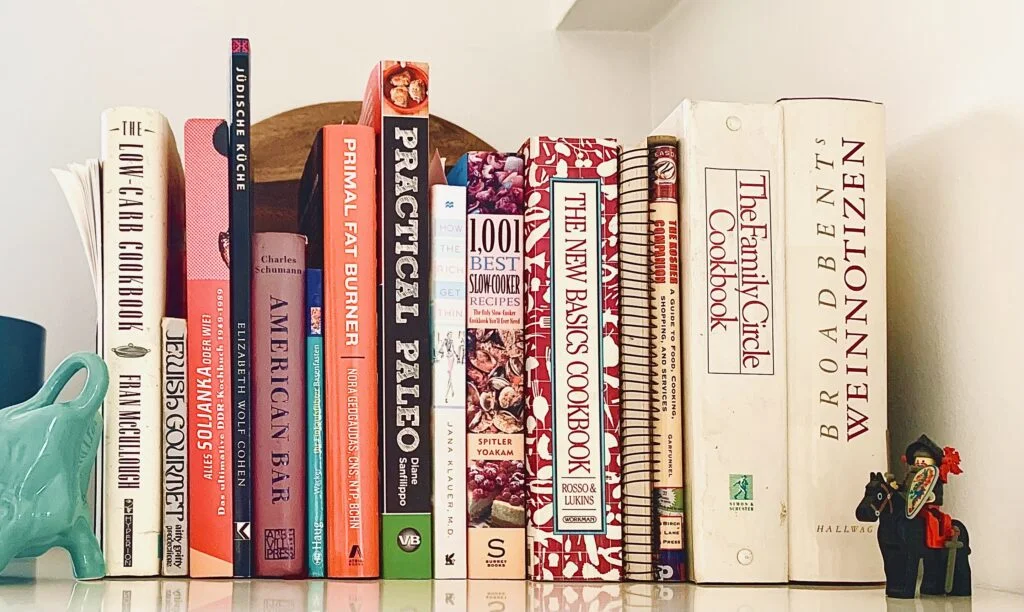
Pick a corner bookcase or just one shelf, and go through your books. You can sort out reference works that are out of date, romantic novels you read once on holiday and will never read again, tattered children’s books, and generally anything you know you’ll never look through again. If you’re unsure what to do with the books you’ve decluttered, check out my post on how to get rid of stuff.
C – Candles
The scented candle market has been booming for the past ten or so years, and according to this study, its growth is expected to compound 8.4% annually by 2025. That’s a lot of candles!
How many do you have around your home, in all honesty? Admittedly, every time I pop into Marshall’s or TkMaxx, I always pick up one or two new candles to have on hand. I love the different seasonal fragrances (green apple in September! cotton candy in June! fresh linen in April! pumpkin spice in November! oud in January, oh my!). I only have one candle out at a time though. This ensures I’ll use it and enjoy it while it is still good. I simply take it to different rooms when I want the scent in a different part of the flat.
Check your stash around the house, and see which ones you can discard. Throw out any candles that are sooty, full of dust, have lost their scent and colour from sitting in the sun, or nearly burnt out to the bottom of the wick. Now tick off the letter C from your declutter printable, because you finished sorting out your candles!
D – Dishrags
When was the last time you sorted through your dishrags, dish sponges and dish towels? This is a super quick task you can do while you’re tending to something on the cooker. Let go of any dishrags that are worn out, badly stained or just nasty looking. Stained dish towels can also get the boot.
Also keep in mind that you should regularly replace kitchen sponges to keep things in the kitchen sanitary. They are a breeding ground for bacteria long before they get smelly. And wiping the kitchen down with a petri dish of germs isn’t very appetizing!
E – Electric Cables, Plugs & Adapters
Do you have a stash of cables and plugs so mysterious, you don’t know what they belong to anymore? Or why you have them? I hear you. During my decluttering challenge this past spring, I also discovered a motley crew of cables I couldn’t figure out. I took them all to the recycling bin and haven’t missed them for a moment since.
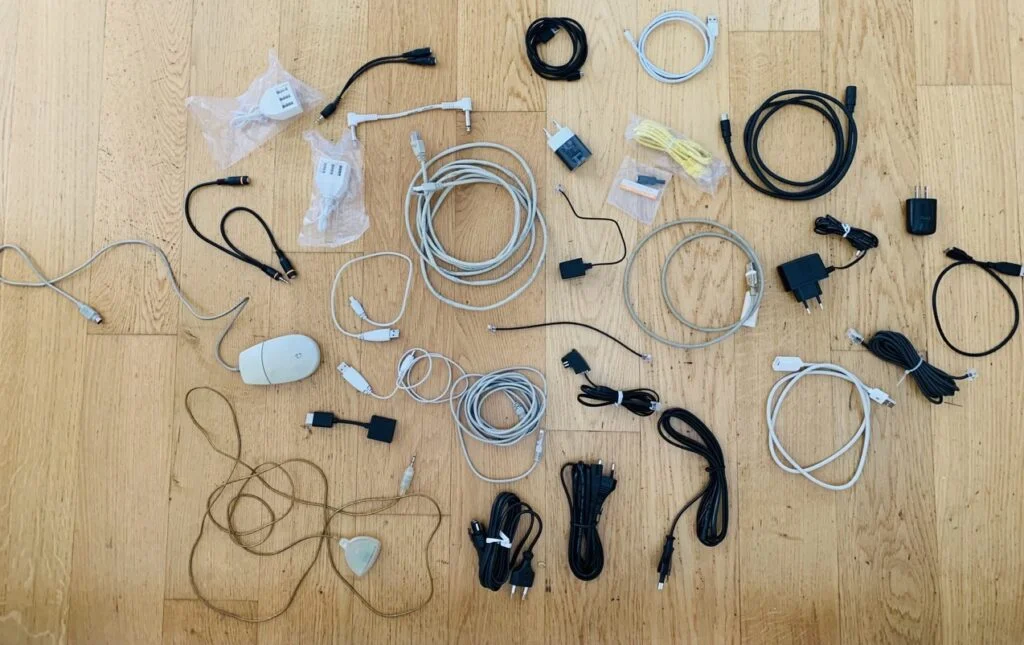
You might have a similar batch of cables in your junk drawer, or stored near your television. Sort through them. If you can’t figure out what’s what, you probably don’t need it and won’t miss it.
F – File Folders
What’s in your file folders? Chances are a lot of paperwork you don’t actually need to keep on paper. There are, of course, certain things you most definitely have to keep in original, on paper. Birth certificates, deeds, estate wills and testaments, licenses, diplomas, contracts, any bonds certificates and the like. The majority of the paperwork we tend to tuck away in folders and files, however, can likely be digitised and disposed of.
If you feel overwhelmed by numerous files, then proceed with this task like you did with books. Pick a couple of folders or a section of the filing cabinet to sort through in one short sitting. Keep all of the above-mentioned vital documents in your paper file. Scan and digitally file anything you might still need. Here again, DEVONthink is great for organising your scanned documents. Alternatively, you could also set up a folder on your computer to house what you’re archiving.
G – Glasses
Whether you wear prescription eyeglasses or sunglasses, have a look through your collection. Eyewear trends come and go, and prescriptions also change. Sort out any broken frames and any styles you no longer like or wear. Next, check to see if you need any prescriptions changed. If you still like the frames, your optician will simply switch out the prescription lenses.
If you don’t like the glasses anymore, check to see where you can donate them in your area. There are many optometrists, opticians and ophthalmologists who participate in eyewear donation programmes. In the United States, you can donate your old glasses at Walmart’s or Lenscrafter’s. In the United Kingdom, you can find an optician who takes eyewear donations for Vision Aid Overseas. Or you can send them to your local Lion’s Club.
Depending on the charity, your old eyewear will help underprivileged folks in your immediate region, or in developing countries. No matter where they wind up, they’re helping other people who can’t afford frames and prescription lenses see better. What a great side effect of some quick decluttering!
H – Hair Accessories
Next up on our declutter list: hair clips, hairpins, hair ties, headbands. We can never find them when we need them. Yet sometimes it feels like they’ve cloned themselves in the depths of a random drawer. Only you can be the judge of how many you need, and what type. If you have a larger stash, or if they’re all over the place, then round them up and start sorting. Discard any hair ties that have worn-out elastics or are dirty. Chipped or broken hair clips can also be thrown away.
Some headbands tend to cause a lot of pressure behind the ears and hurt, or even cause a headache. If you have any of those, let them go. Also say goodbye to any bent or chipped hair pins. You can arrange any remaining hair accessories you decide to keep in a pretty jar in the bath. You might also want to pop an extra hair tie in your handbag in case you need one while you’re out.
I – Invoices
Invoices are another great example of things which can be digitised, decluttered, and archived digitally. I scan mine directly into DEVONthink. Depending on the type of invoice, a lot of them need to be saved for annual tax returns or insurance purposes. Whether you use a notes-taking app or a file system on your computer, you can set up folder hierarchies to suit your purposes.
For taxes, for example, you could have a main folder called “Digital Archive,” then a “Taxes” folder in there, and inside that you can set up individual folders by year, e.g. “2021,” and then create your “Invoices” sub-folder nested in there. You’ll never again wonder where your tax-deductible invoice for a home repair is.
J – Jewellery
Declutter your costume jewellery and make space for the stuff you really love to wear. Some inexpensive jewellery has the tendency to turn green or tarnish. These are the pieces you can let go, along with anything that has broken clasps or missing charms. If you have some pieces that are still in good condition, but you just don’t like, see if a friend, neighbour, or family member would like to have them. They might be delighted by a “statement” necklace you picked up at a Topshop sale, yet never wore.

I also recently decluttered some of my costume jewellery, and now I have more room for my nicer pieces. Plus, it’s easier to see what I have and decide what to put on, without having to rummage through items I don’t like.
K – Knickknacks
Admittedly, weeding out knickknacks is a bit hard. We tend to hold on to a variety of different, seemingly useless items for purely sentimental or decorative reasons. Then they sit on the shelves and on our bookcases for years, collecting dust.
I do enjoy knickknacks myself, and I like displaying them. But I am wary of bringing more into my home. Over time, I’ve become very selective when browsing souvenirs abroad, or perusing the aisles of a store’s decor section. Cleaning and dusting shelves chock full of stuff all the time is no fun.
If you have a lot of bric-a-brac, you might want to just go through one single room at a time. Grab a dust rag and a small box while you’re at it. Pick up each item, wipe it off, think about where you have it from and why, and ask yourself if you really wish to keep it. Set aside anything you’re decluttering in the box. Once you’re done, you can then decide which of the decluttered items are to be thrown out, gifted, or perhaps sold on eBay or at a boot sale if they’re collectibles.
L – Linens
This is a fairly quick and easy home organisation task you can do on laundry days. Sort out any bed and bath linens which are stained, torn, or tattered. They’ve done their service and now it’s time to say goodbye.
If you have any home repair projects coming up in the near future, such as painting, you might like to hang on to your decluttered linens to use during cleanup or to protect furniture. Alternatively, if you have dogs which you frequently transport, you can use old linens to line their space in the car so it gets less dirty. If you have no such further use for your linens, give them to your local textile recycler such as The American Textile Recycling Service in the US or the Clothing Recyclers in Australia, or run them over to your municipal recycling compound.
M – Medicine
I live alone so I don’t have a very large medicine cabinet, just a little Ikea container I keep some plasters and emergency medicine in. Nonetheless, this stuff still has an expiration date, so it needs to be decluttered from time to time. Example? Here’s what my last medicine declutter session yielded:
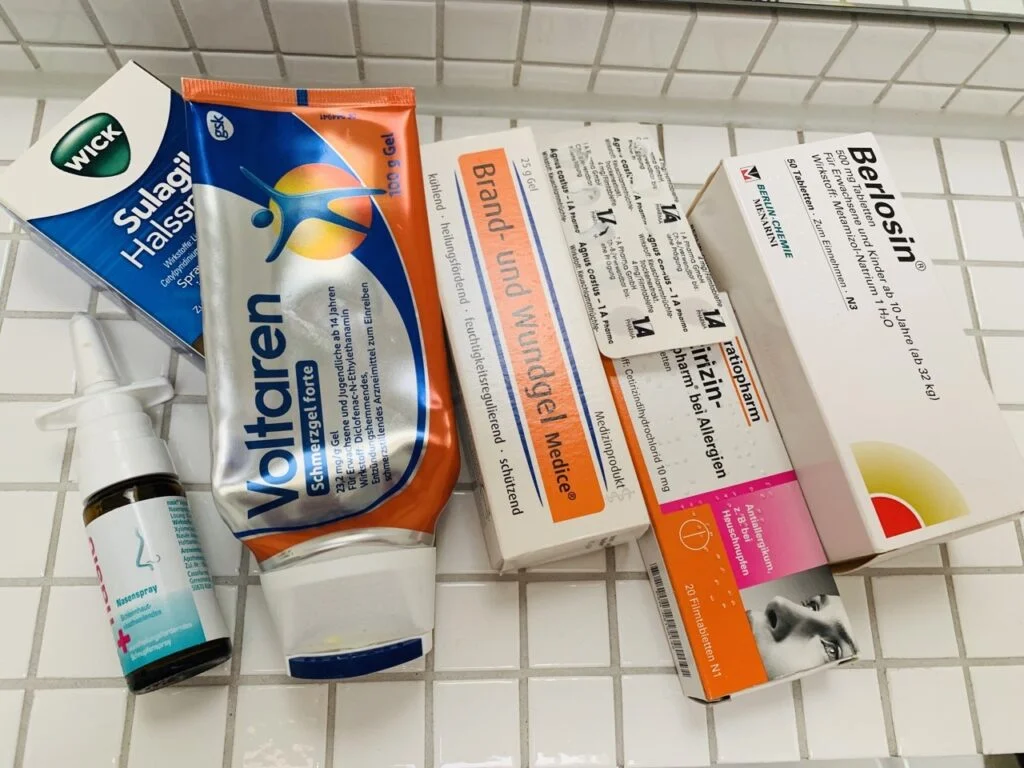
Look at you, you made it to letter M on the free printable decluttering checklist. You’re halfway done! Let’s stay in the bathroom for our next step before we move on to the closet.
N –Nail Polish
Hands on your hearts: how many bottles of old nail varnish do you have? When was the last time you honestly wore that neon green or black polish from fashion trends of yonder? Have a peak inside your collection. Discard any colours you don’t like, and any bottles that have dried up or gone the route of sticky-gunky. While you’re at it, toss out those worn down nail files and emery boards, too.
O – Outerwear
Spring/summer is actually a terrific time to sort through your outerwear, try everything on, and declutter what no longer fits or is worn out. The benefit of doing this is two-fold. Not only do you have an emptier closet come autumn, but if you need any replacement coats or jackets, spring to early summer is good time to get last season’s models at a significant discount well ahead of the cooler weather. Once summer starts winding down, outerwear is usually only available at full price.
By sorting through your outerwear now, you also have the opportunity to check if anything needs to go to the dry cleaners or be mended before autumn. Taking care of this maintenance now means you won’t be pulling a coat out of your closet when it suddenly gets cold in October, which is missing its buttons or has a stain from last winter on it!
If you need some ideas for donating any outerwear in good condition which you’ve decluttered, check out my tips for donating clothing.
P – Pens, Pencils & Paintbrushes
This is another relatively easy category you can quickly sort out. Go through your desk drawers and throw out any worn down pencils and pens that no longer have ink. If you have craft supplies, have a look through your paintbrushes, too. If they are dried out, have lost their bristles, or are too dirty to use again, let them go along with the old pens and pencils.
Q – Quilting supplies
Ok, I cheated here a bit with my free printable decluttering checklist. I couldn’t think of any clutter to add that starts with the letter Q. Q-tips don’t count! 😅 Quilting supplies are legit though if we expand the notion to include any sewing and hobby supplies you haven’t used in a long time.
Have a look through your sewing kit, your stash of needlework gear or your knitting supplies to see if there’s anything you can let go. You might find scraps of fabrics you have no use for, needles that are no longer sharp, or old yarn spools that are empty. Sort them out and let ’em go.
Why Decluttering Hobby Supplies is Emotional
It can be very emotional letting go of hobby supplies, I know this all too well myself. Perhaps it was once a hobby you pursued with all your passion before it fell by the wayside when your career started taking off. Perhaps it was a hobby which represented a life dream or career goal, and now the supplies sit there collecting dust. A constant reminder that you did not achieve what your heart desired.
It’s hard to confront those sentiments, and that’s why going through these supplies can be so difficult. We procrastinate, always telling ourselves that perhaps one day things will change and we’ll pick them up again.
During my 30-day challenge I let go of a huge lot of photographic equipment and cameras. It was hard. I had held on to some of that stuff for well over thirty years. As a teenager and young adult, I had truly wanted to become a photographer. Things turned out quite differently for me, though. I finally jumped past my own shadow and donated everything to a charity for underprivileged children. Once the equipment was picked up, I did feel a vague sense of remorse. When I thought of the kids who were going to get to experiment with all my gear, though, it really lifted my spirits. Maybe one of them will become the photographer I could never become.
R – Receipts
Where do you keep your receipts? Are they strewn at large in between your handbags, your paper tray, the kitchen counter, and your file folders? Time to declutter and sort them. First off, you will need to differentiate between personal and business receipts.
Decluttering Business Receipts
If you run your own business you’ll want to keep your receipts for at least seven years. In some places, it’s even ten years. Ask your local tax authority exactly how long you need to keep them, and if they require you to keep the original paper receipts or if you may digitise them and discard the originals.
If you’re employed and regularly file expense reports, you’ll need to scan the receipts for any business expenditures for your employer. Some employers also require you to hand over the original paper receipts. Check with your firm’s finance department or expense team if you’re unsure what they need from you.
Decluttering Personal Receipts
For personal expenditures, the only receipts you really need to keep are the ones for larger purchases as proof of purchase for e.g. your insurance company, or for any warranty claims. Receipts for day-to-day expenditures like groceries, household supplies, or clothing can generally be thrown out once you’ve cross-checked your bank or credit card statements to ensure everything was correctly charged.
The personal receipts you do need to keep for insurance or warranty purposes should be scanned. Then either save them to DEVONthink as described above (see A, F, and I), or to a digital archive you’ve structured on your computer or on Dropbox. Even if you do decide to keep the actual paper receipts in your files, you should consider scanning those from major purchases. Should anything ever happen to your home, you will be glad to have a digital backup for your insurance company.
S – Sneakers
Unless you’re a sneakerhead, this should be a pretty quick task. It’s time to inspect your trainers and sneakers! Weed out any pairs that have worn out soles or worn down arch support, are badly stained, irrecoverably dirty, or smell bad 🤢
Don’t forget to tick the letter S off your list. You’re getting closer to the finish line now, keep on going!
T – T-Shirts
I recently spent half an hour organising my t-shirts. I swear I could have worn a different t-shirt each day for at least two months! Most of them were not nice looking anymore, and just taking up precious space in my drawers. Sound familiar? I chose to keep four tees from my youth I am very sentimental about. I got rid of all the other old and grungy ones.
Take a few minutes and go through your own t-shirt stash. Sort out the ones that don’t fit, have holes, are stained, or have product logos you have no attachment to. I got rid of every single t-shirt with my former employer’s logo on it, for example, and it was liberating. I had accumulated so many in over eleven years at the company, and no longer wanted to wear them.
And no, you don’t need to hold on to ten yucky tees just in case you do some home renovations at some point in the future. By the time that day rolls around, you’ll have a new “old” t-shirt you can mess up, trust me!
U – Underwear
Ripped, stained, torn undies? Bras that don’t fit properly? Say goodbye. They don’t make you feel attractive, and they’re cluttering up your drawer.
V – Vitamins
Where do you keep your vitamins? I store mine in the kitchen because I really do take them every day. If you have yours in the bath, pantry, or in a closet, it’s time to check your stash. Declutter any bottles of vitamins which have expired. Bring those set to expire soon to the front so you use them up first.
Much like expired medicine, it’s a good idea to bring any expired vitamins back to the chemist or pharmacy next time you go. This way they will be correctly disposed of. Tossing these things out with your regular garbage means they’ll wind up on a landfill and ultimately in our groundwater.
W – Wire Hangers
When you have clothing dry-cleaned or professionally ironed, they typically come back home to you on wire hangers. I don’t recommend using those to actually hang your clothing. They are too thin, can rust, and cause the garments to wrinkle, which defeats the purpose of having them pressed in the first place.
It makes sense to get into the habit of re-hanging your dry-cleaned clothes when you bring them home. Put them back on your own hangers, and create a dedicated area to collect the wire hangers. Next time you go to the cleaners, take the wire hangers back to them.
Despite my closet being small, I made a designated drawer in my wardrobe for the ironing and dry cleaning piles. I corral the wire hangers in this drawer so that I do not forget to take them back when I grab the pile of clothes for the dry cleaner.
If you don’t rely on dry cleaning services yet still have a bunch of wire hangers in your closet, you might want to bring them all to recycling before they damage your garments. Replace them with hangers that have a uniform size and look. This will make your closet instantly look more organised. Velvet hangers are very popular with home organisers for good reason: they are slim, clothing cannot slip off, and they’re more inexpensive than lacquered wood hangers.
X – Xerox copies
Do you still have xerox copies from your uni days, from work, or from recipes? Declutter them. If you have any copies of anything that was imperative you hang on to, scan them into your digital archive or tag them in your notes app so you can quickly find them again.
Y – Yarn
Declutter any bundles of yarn leftover from craft or knitting projects. Or any yarn from projects you never completed. If you have a larger lot of yarn, you might want to put it up on eBay for someone else to use. Also rein in your gardening yarn, too, if you have any. Any balls with less than a metre left are likely not going to be much help in the garden.
Z – Zines
Wow, you’ve made it all the way to Z on the free printable decluttering list! If you’re not a zine collector like I am, you can interpret this one as magazine. Whether large or small circulation, if you have magazines stacking up throughout your home, take some time to declutter them. Drop the ones you’ve read in the paper recycling bin, or consider selling any collector editions.
Certain libraries accept donations of self-published zines. Do a search and find out where before you discard those little gems.
If you’re finding it hard to part with a zine or magazine because you loved certain articles or images, whip out your note-taking app and save them to your digital archive for forever. You can always go back to them on your mobile or computer, and they won’t be cluttering up your physical space anymore!
Grab Your Free Printable Decluttering Checklist
That’s it for my easy A–Z cheat sheet. I hope you found it useful! If you would like to save it, add your own ideas to it, or use it as future reference, be sure to download the home declutter checklist as a PDF version here. Its just one page, and you can also add your own to-dos to it.
Let me know in the comments if you found it useful, and good luck with your next declutter session!



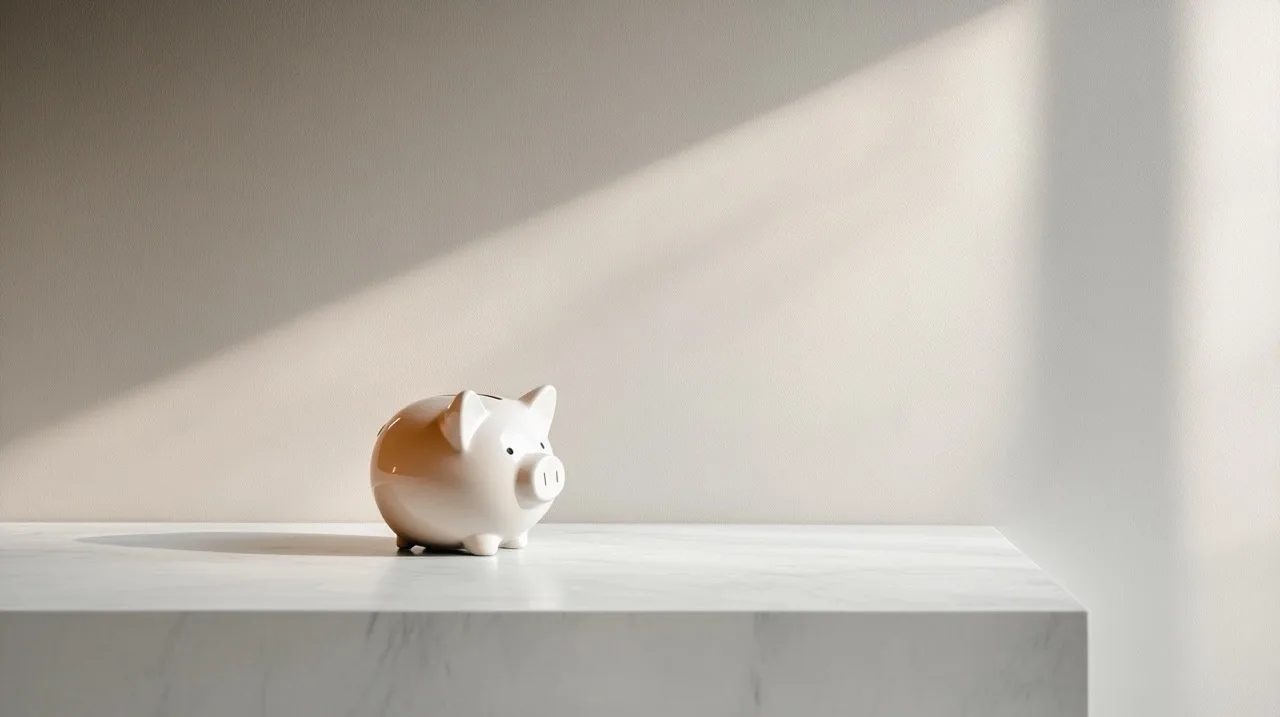


Leave a Reply